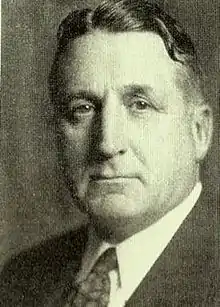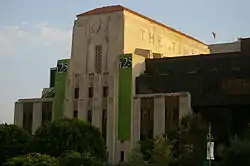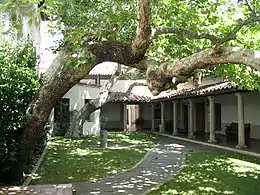Gordon Kaufmann
Gordon Bernie Kaufmann (19 March 1888 – 1 March 1949)[2] was an English-born American architect mostly known for his work on the Hoover Dam.
Gordon Bernie Kaufmann | |
|---|---|
 | |
| Born | 19 March 1888 Forest Hill, London, United Kingdom |
| Died | 1 March 1949 (aged 60) Los Angeles, California |
| Nationality | United States |
| Alma mater | London Polytechnic Institute |
| Occupation | architect |
| Known for | Work on the Hoover Dam |
| Spouse(s) | Eva A. Kaufmann (two sons) Elsie S. Bryant[1] |

Early life
On 19 March 1888, Kaufmann was born in Forest Hill, London, England.[3]
Education
Kaufmann attended Whitgift School in south Croydon, and went on to graduate from the London Polytechnic Institute, circa 1908. Kaufmann then moved to Vancouver in British Columbia, where he spent the next six years.
Career
During Kaufmann's early career, he did much work in the Mediterranean Revival Style, which had become popular at that time. He was also the initial architect for Scripps College, a liberal arts women's college in Claremont, California. It is a member of the Claremont Colleges.
Kaufmann, along with landscape architect Edward Huntsman-Trout, designed the general campus plan featuring four residence halls to be built the first four consecutive years of the College (1927–1930). The project's design is primarily in the Mediterranean Revival style.[4]
While gaining recognition for Kaufmann's work on the Scripps campus, he was also hired by California Institute of Technology in 1928 to design the complex of dormitories now known as the South Houses, and the building for the Athenaeum, a private club located on the school's campus.[5]
Later in his career, Kaufmann worked primarily in the Art Deco style, with a personal emphasis on massively thick, streamlined concrete walls which gave his buildings a very distinctive appearance. Kaufmann's buildings as a result took on a very "mechanical" appearance, often resembling huge versions of old-fashioned appliances. The Los Angeles Times' headquarters is a perfect example of this. His work was also part of the architecture event in the art competition at the 1936 Summer Olympics.[6]
Projects
This is a selected list of Kaufmann's projects.
- 1928 Greystone Mansion – 905 Loma Vista Dr, Beverly Hills, California. Architect.[7]
- 1929 Masonic Clubhouse, now the Geffen Playhouse Theater, 10886 LeConte, part of the master-planned Westwood Village, Los Angeles
- 1934 Santa Anita Park
- 1935 Hoover Dam
- 1935 Los Angeles Times Building – 202 West 1st St, Los Angeles, California. Architect.
- 1940 Hollywood Palladium – 6201 W. Sunset Blvd, Los Angeles, California. Architect.[8]
- 1947 Beverly House – 1011 N. Beverly Dr, Beverly Hills, California. Architect.[9]
Personal life
In 1914, Kaufmann moved to California and settled in Fresno, California. Kaufmann's wife was Elsie Bryant Kaufmann. On 1 March 1949, Kaufmann died in Los Angeles California. Kaufmann is buried in Golden Gate National Cemetery in San Bruno, California.[10]
References
- "Gordon Bernie Kaufmann (Architect)". pcad.lib.washington.edu. Retrieved 23 September 2016.
- Pacific Coast Architecture Database. Retrieved 10 June 2014 (bad link)
- "Gordon Bernie Kaufmann (Architect)". pcad.lib.washington.edu. Retrieved 16 June 2019.
- "Scripps College Historical Timeline". Archived from the original on 11 December 2012.
- "The History of the Athenaeum".
- "Gordon Kaufmann". Olympedia. Retrieved 11 August 2020.
- "Greystone Mansion". beverlyhills.org. Retrieved 17 June 2019.
- "Hollywood Palladium". laconservancy.org. Retrieved 17 June 2019.
- "Beverly House". beverlyhouseestate.com. Retrieved 17 June 2019.
- "Gordon Bernie Kaufmann". Find a Grave. Retrieved 17 June 2019.
| Wikimedia Commons has media related to Gordon Kaufmann. |

